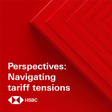Become a Creator today!Start creating today - Share your story with the world!
Start for free
00:00:00
00:00:01

The Macro Brief – The big, beautiful, US edition
Ryan Wang, US Economist, talks through the latest in the US – including “phase two” of tariffs, tax cuts and deficits, and the path of rate cuts. Disclaimer: https://www.research.hsbc.com/R/101/DlDVjKM
Stay connected and access free to view reports and videos from HSBC Global Investment Research - follow us on LinkedIn https://www.linkedin.com/feed/hashtag/hsbcresearch or click here https://www.gbm.hsbc.com/campaigns/global-research
Transcript
Introduction to HSBC Global Viewpoint
00:00:02
Speaker
Welcome to HSBC Global Viewpoint, the podcast series that brings together business leaders and industry experts to explore the latest global insights, trends, and opportunities.
00:00:13
Speaker
Make sure you're subscribed to stay up to date with new episodes. Thanks for listening, and now onto today's show.
00:00:23
Speaker
This podcast was recorded for publication on the 10th of July 2025 by HSBC Global Investment Research. All the disclosures and disclaimers associated with it must be viewed on the link attached to media player.
00:00:34
Speaker
And don't forget to like and subscribe to The Macro Brief wherever you get your podcasts.
US Tariffs and Taxes Discussion
00:00:40
Speaker
Hello and welcome to the Macro Brief, where we look at the issues driving financial markets across the globe. I'm Aline Van Dyne, Global Managing Editor, and this week we're coming to you from New York with our focus firmly on the US.
00:00:55
Speaker
And we'll be talking tariffs, taxes and much more. So recently, President Trump signed the so-called Big Beautiful Bill into law, paving the way for tax reductions and higher US deficits.
00:01:10
Speaker
on the trade front the long-awaited 9th of july deadline for the introduction of reciprocal tariffs appears to have been pushed to the first of august but there have also been a few surprising developments there and on the economic front we look at what's expected for growth and inflation as we look towards the federal reserve's next policy rate meeting at the end of the month So lots to unpack.
00:01:37
Speaker
And to help me do that, I'm joined by Ryan Wang, our U.S. economist. Hi, Ryan. Welcome back to the Macro Brief. Thanks, Aline. Great to be here. So let's start with tariffs.
00:01:48
Speaker
This week was an important one because there was a 9th of July deadline for more developments, more information on the so-called reciprocal tariffs that were introduced in April.
00:01:59
Speaker
Now, a number of countries have received letters with new levels of tariffs, which will be introduced on the 1st of August. So I suppose first of August, seems like a new deadline and negotiations continue in terms of some trade deals, et cetera.
Impact of Delayed Tariffs on Businesses
00:02:16
Speaker
um But Ryan, just from the perspective of analyzing tariffs and the economy, what what what developments are you watching out for now? Where do we stand?
00:02:28
Speaker
Yeah, that's absolutely right. There had been a lot of anticipation for this July 9th deadline ever since the original enumeration of various so-called reciprocal tariff rates in early April.
00:02:39
Speaker
And in the event, as you mentioned, we mostly have a delay since the new tariff rates, the ones that have been announced in a series of of letters so far this week, ah will not be imposed until August the first So in a way, we're merely delaying the uncertainty.
00:02:57
Speaker
ah For businesses currently, the reciprocal tariffs still are at a minimum 10% all country baseline, if you like, with some significant sectoral exemptions.
00:03:08
Speaker
And of course, in in many cases, the delay to August the 1st is to give some more time for bilateral discussions between the US and various trading partners.
00:03:19
Speaker
And so businesses, for the time being, will just have to keep waiting and watching. So even in those letters, of course, there were some surprises. Some of the tariffs suggested, for example, to Korea and Japan of 25% was similar to what was indicated in April. But then Brazil got a letter saying that tariffs would go to 50% as of the 1st of August. So ah any other surprises, anything else in terms of added uncertainty?
00:03:47
Speaker
The biggest surprise so far was that 50% number announced for Brazil. And the reason for that is because Brazil previously had been part of the essentially the 10% group, the kind of minimum reciprocal tariff. So that was the biggest standout in terms of a difference in terms of the difference between the announced numbers this week.
00:04:07
Speaker
and the previous indication from early April. That said, once again, none of these are set to be imposed in the immediate term, so clearly there's still gonna be uncertainty about if and when those higher tariff rates, higher than 10%, actually come into force.
Sectoral Tariffs and Investigations
00:04:24
Speaker
So Ryan, stepping away from the reciprocal tariffs, that of course is not the whole story. Sectoral tariffs are also in play. Where are we on that front, and how important is that?
00:04:36
Speaker
Yeah, that's right. I mean, one way of thinking about it is that we are entering a second act of potential uncertainty related to U.S. tariffs. As I mentioned, the reciprocal tariffs that are in force currently and even the ones that are proposed do have significant sectoral exemptions, meaning where the U.S. has commenced a so-called Section 232 investigation,
00:04:58
Speaker
into ah into these various products, those products have not faced higher tariffs up to this point. And there is a lengthy list. Over half a dozen products have had investigations commence this year, ah starting with copper, including timber and lumber, semiconductors, pharmaceuticals, critical minerals, aircraft.
00:05:16
Speaker
So it's a long list of products. And we are big sectors for the economy. That's right. I mean, there has been clearly a lot of attention on some of these big, big import sectors, again, including pharmaceuticals, including semiconductors, with lots of ramifications, both for the U.S. and for the global economy, the exporting exporting flows.
00:05:36
Speaker
So, um we do have some indication as of this week that perhaps those in the first of those investigations might be drawing near its conclusion and that is for copper. ah The US administration has indicated that that investigation may be very close to conclusion and therefore has mooted the possibility of a 50% tariff on that product.
00:05:57
Speaker
And do potentially these sector tariffs, are they potentially applied on top of country specific reciprocal tariffs? Like, does it all compound or is it does one cancel the other out or do is that another area that we're not quite sure how it's going to work?
00:06:15
Speaker
Well, they're they're in not intended to to stack on top of each other, which is why, you know, for the most part, reciprocal tariffs, the exemptions, are related to investigations that are forthcoming.
00:06:28
Speaker
They, in a way, are working are intended to work part and parcel, where one tariff rate would apply for sectors, and then products that do not face sectoral tariffs would therefore be subject to those country-specific reciprocal numbers.
00:06:42
Speaker
Thanks, Ryan. So let's do a pivot to another big T word, taxes, ah the big, beautiful bill. a lot of legislation, a lot of different parts to it, but one is the extension of tax provisions.
00:06:56
Speaker
ah Just tell us a bit more about that. What are the important elements from a tax perspective? And then how does that relate to deficits, which of course is a crucial question?
00:07:08
Speaker
Yeah, that's right. I think the broad contours of the recently enacted Republican reconciliation package generally conform to expectations in the sense that the biggest part was the extension of various tax re provisions that were scheduled to expire at the end of this year.
00:07:25
Speaker
These were mostly tax cuts, not all tax cuts, but generally speaking, tax cuts for businesses and households that were enacted in 2017 and simply had a deadline. So now that deadline has largely been removed.
00:07:37
Speaker
ah But on top of that, there ah were some additional tax changes. Two that I would point to, one, on the business side, there are incentives for for business investment essentially, immediate expensing for research and development, expensing for structures investment and equipment investment.
00:07:55
Speaker
And then on the household side of the equation, there were some tax modifications for taxation of overtime and taxation of tips. And so that will reduce effective taxes for some households.
00:08:10
Speaker
Are overtime and tips a big part of of income, like in the aggregate, in the economy? Well, it's still a minority compared to the overall entire workforce. And also it's worth noting that there were some income limits on the new tax changes that will start to to to affect workers who who who who earn overtime and tips.
00:08:30
Speaker
So it does have some effect of amounting in budgetary terms to perhaps tens of billions of dollars. Still significant, but perhaps not as large as a full-fledged implementation of ah no tax on tips or no tax on overtime would entail.
00:08:44
Speaker
What is all this going to cost?
Federal Budget Deficit Concerns
00:08:46
Speaker
Well, that's a very interesting question. And I think it's important to start with where we were even coming into this legislation, which was a federal budget deficit that's already quite large. We estimate it will approach nearly $2 trillion dollars this year, even for a $30 trillion dollar annual nominal US g GDP economy.
00:09:04
Speaker
$2 trillion is still quite large, roughly around that 6.5% of GDP level. So that's the starting point. And I guess what I would say is that this package at a minimum will keep the deficit at that high level.
00:09:17
Speaker
Perhaps it will even step up a little bit, ah but it's unlikely based on how how the provisions have been enacted that the deficit will fall next year relative to this year. And this is despite attempts to cut spending?
00:09:30
Speaker
Well, that's right. I guess the way that I would frame it is is that there were some efforts to partially offset some of the cost of both the primarily the tax cut extension, but also some of those additional tax cuts that I mentioned on both the business side and individual side.
00:09:47
Speaker
So there are some offsets, but not likely to be enough to offset the entire tally for the budget deficit. And 6.5% debt to GDP, is that is that what we're talking about or deficit to GDP?
00:10:05
Speaker
Yeah, so that's that's that's interesting. it is It is relevant. Both are relevant. So the deficit to GDP running at around 6.5% combined with a debt to GDP ratio at about 100% of US GDP. Well, that is some cause for concern. And also it has led to an increase in the interest share of that 6.5% GDP deficit. Roughly speaking, as many as three percentage points can be It reflects really the interest cost. And so the so-called primary deficit in the United States is around 3.5%. And another way to think about it is that even with a relatively optimistic GDP growth assumption of, let's say, 5% in nominal growth terms, well, if you're running at a 6.5% deficit, it simply means that even with a relatively favorable growth outcome, the debt stock will still rise relative to the economy.
00:10:57
Speaker
So it would need to be closer to 5% for it to be more sustainable? That's right. So it's partly because the debt level is already elevated and it's partly because the underlying deficit, both in terms of the interest share but also the primary deficit, are simply a bit too high relative to to even an optimistic growth assumption.
00:11:19
Speaker
And Ryan, is there any connection between this discussion, ah the new legislation and tariffs, like ah tariffs bringing out in income? Is there any offset on that front? Is there any connection or are these sort of two separate factors to consider for the US economy?
00:11:39
Speaker
Well, I do think they're both relevant and somewhat connected considerations. It is true that we've already seen an increase in in tariff revenue over the last few months from approximately less than $10 billion per month last year to as much as over $20 billion in the month of May.
00:11:56
Speaker
So I do think that over the course of the year ahead, we can probably expect increased tariff revenue of at least an additional $100 billion per year. So that is not an insignificant number, and it does provide a bit of a revenue offset relative to the tax reductions I was just talking about.
00:12:14
Speaker
you know i would In a way, I would think about both of these elements as opposite sides of the same coin. The lower taxes from the reconciliation package should all else the same provide a bit of a near-term boost to ah economic growth over the year ahead, but at the expense of a larger budget deficit.
00:12:33
Speaker
and And in a way, the tariffs are the opposite. It's more tax revenue for the federal government that, of course, is being largely paid by U.S. businesses and households. Taking all of that together and many other things that we haven't had time to talk about yet, what does this mean for growth and inflation?
Economic Growth and Tariff Effects
00:12:51
Speaker
Well, we're still expecting that growth will decelerate closer to a sub 2% level in real terms in the second half of this year.
00:13:02
Speaker
And also we'll be closely watching to see whether and when tariffs really generate some upward impact on consumer prices. So far the evidence of that has been somewhat ah limited.
00:13:14
Speaker
ah But we know that businesses are in part running down their pre-tariff inventory levels and so over the months ahead we do think core inflation will move higher, closer to that 3% level. So both of those considerations are going to be very important to watch.
00:13:29
Speaker
And of course you're watching it but so is the Federal Reserve. What does this mean, what does this backdrop mean in terms of interest rate expectations? We're holding to the view of 75 basis points of rate cuts over the essentially the next year and a half. And so we have those rate cuts coming in 25 basis point steps in September, December, and next March.
00:13:53
Speaker
ah But again, these are going to be subject to how the data evolve. ah The labor market up until this point has been relatively resilient. And actually, the latest data on the unemployment rate actually edged down a little bit.
00:14:07
Speaker
ah But at the same time, as I mentioned, we're still waiting for some of the more full effects from the inflation side to to show. And we do think that goods prices will begin to rise at least somewhat in the months ahead, which will further complicate the Fed's decision making.
00:14:21
Speaker
Do you think there'll be more information on this ahead of the FOMC's next meeting at the end of July? i think in terms of news before the meeting at the end of this month, it's is going to be relatively limited. As I mentioned, we won't have any more monthly labor market data. We will have one more set of consumer price information. but Really, we're focused more on that September meeting, at which time the Fed will be able to see a few more monthly reports on each side.
00:14:52
Speaker
Well, Brian, thank you for putting some context around all this. Clearly, still a lot of uncertainty, ah including on the tariff front, but also on inflation and other key U.S. economic indicators. So it sounds like we need to get you back here in a few weeks' time to see where we are.
00:15:10
Speaker
Thanks so much, Aline. Thank you.
Upcoming LinkedIn Event on Sustainability
00:15:15
Speaker
Now before we go, our next Live Insights event on LinkedIn is taking place on Tuesday the 15th of July. The topic this time is sustainability. Piers Butler, my co-host of the podcast, will be joined by Zoe Knight, our Global Head of Sustainability Research and Integration, to discuss the main findings of our recent survey of investors on sustainability issues.
00:15:41
Speaker
You'll also have a chance to ask Zoe your questions, so head to LinkedIn and search hashtag HSBCresearch for full details on how to sign up. So that's it for this week's podcast.
00:15:54
Speaker
If you have any questions or comments about anything we've talked about today, then please email us at askresearch at hsbc.com. And if you're listening to us for the first time, well, thank you. But don't forget to like and subscribe to The Macro Brief wherever you get your podcasts.
00:16:12
Speaker
Until next time, thanks very much for joining us here on The Macro Brief.
00:16:36
Speaker
Thank you for joining us at HSBC Global Viewpoint. We hope you enjoyed the discussion. Make sure you're subscribed to stay up to date with new episodes.
















